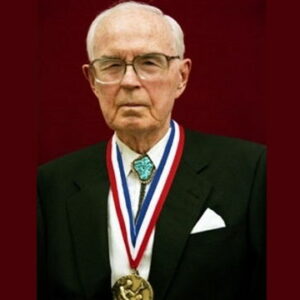Willis Eugene Lamb Jr. was an American scientist who won the Nobel Prize in Physics for identifying a minute difference in a hydrogen atom’s energy levels. His discoveries prompted a rethinking of the fundamental principle underlying the application of quantum theory to electromagnetic. The ‘Lamb shift’ is a variation in the energy level of an electron circling around the nucleus of a hydrogen atom. The discovery had a significant impact on the concept of quantum theory as it applied to matter. He shared the Nobel Prize with Ploykarp Kusch, a German-American physicist who came to the same results while conducting the experiment independently. At the age of 26, he anticipated the ‘Mossbauer Effect,’ also known as the ‘Lamb-Dicke-Mossbauer Effect,’ which was proved 20 years later. His research included theories of matter-neutron interactions, fission fragment ranges, nuclear structure theories, cosmic ray shower variations, beta decay theories, pair formation, order-disorder problems, quadrupole interactions in molecules, and diamagnetic corrections for nuclear resonance. He also researched the fine structure of hydrogen, helium, and deuterium atoms, as well as the design of magnetron oscillators, the theory of electrodynamic energy level displacements, and the theory of the microwave spectroscope.
Childhood and Adolescence
Willis E. Lamb was born on July 12, 1913, in Los Angeles, California, United States. Willis Eugene Metcalfe was a telephone engineer, and Marie Helen Metcalfe was his mother.
Perry, his younger brother, was his only sibling.
He first studied for three years in Oakland, California, before enrolling in a Los Angeles public school.
He majored in mathematics, physics, and chemistry when he graduated from ‘Los Angeles High School.’
In 1930, he enrolled at the ‘University of California in Berkeley, where he earned a B.S. bachelor’s degree in chemistry in 1934.
He earned his doctorate in theoretical physics and wrote his thesis under J. Robert Oppenheimer, who eventually became the director of the Manhattan Project.
Lamb’s dissertation on the electromagnetic properties of nuclear systems earned him a doctorate from the ‘University of California in Berkeley in 1938.
Willis Lamb’s Career
Willis E. Lamb began his career as an ‘Instructor in Physics at Columbia University’s physics department in 1938. In 1943, he was promoted to Associate Professor, From 1943 to 1951, he worked at the ‘Columbia University Radiation Laboratory’ on how to create radar sources that could emit shorter microwaves at higher frequencies during WWII. Later on, this effort helped him win the Nobel Prize.
In April of 1947, he conducted an experiment in which he discovered the ‘Lamb shift,’ a movement in the energy levels of a hydrogen atom.
From 1951 to 1956, he was a ‘Professor of Physics’ at the ‘University of Stanford,’ where he taught atomic spectroscopy.
From 1953 to 1954, he worked as a ‘Morris Loeb Lecturer at ‘Harvard University.’
From 1956 until 1962, he was a ‘Wykeham Professor of Physics and a Fellow of ‘New College’ at the ‘University of Oxford in England.
In 1962, he became a “Henry Ford II Professor of Physics” at Yale University, and in 1972, he became a “J. Willard Gibbs Professor of Physics.” He remained in that position until 1974.
In 1974, he began working at the ‘University of Arizona Optical Sciences Center,’ and in 1990, he was promoted to ‘Regent’s Professor of Physics and Optical Sciences.’
After retiring from active teaching at the institution in 2002, he worked from his office on the ‘University of Arizona campus.
His Major Projects
From 1947 to 1953, Williams E. Lamb published a series of studies in the journal ‘Physical Review.’ Atomic physicists all across the world recognized these articles as masterpieces.
Achievements & Awards
In 1953, the ‘American Academy of Arts and Sciences’ presented Williams E. Lamb with the ‘Rumford Premium Award.’
In 1954, the ‘University of Pennsylvania’ awarded him an honorary D.Sc. degree.
In 1955, he was awarded the Nobel Prize in Physics as well as the Research Corporation Award.
In 1992, he was awarded the ‘Einstein Medal’ by the ‘Society for Optical and Quantum Electronics.’
The ‘Physical Society of London’ presented him with the ‘Guthrie Award.’
In 1999, he was elected to the ‘National Academy of Sciences and the ‘Optical Society of America named him an ‘Honorary Member.’
In addition, he was named a “Fellow of the American Physical Society” and a “Foreign Member of the Royal Society of Edinburgh.”
In 2000, he was awarded the ‘National Medal of Science,’ the nation’s highest accolade for scientific achievement.
‘Oxford University, ‘Yale University, ‘Yeshiva University, ‘Gustavus Adolphus College’, and ‘Columbia University’ all bestowed honorary degrees on him.
Personal History and Legacy
In 1939, he married Ursula Schaefer, a German history student at the ‘University of Arizona.’
He married Bruria Kaufman, an Israeli physicist whom he met in Columbia in 1941, the same year after Ursula died in 1996, and divorced her later.
On January 26, 2008, he married Elsie Wattson, whom he had met 27 years before. He had no children from any of his previous marriages.
Willis Eugene Lamb died on May 15, 2008, at the age of 94, at the University Medical Center in Tucson, Arizona, following complications from gallstones.
The ‘Willis E. Lamb Award’ for ‘Laser Science and Quantum Optics’ was established by the ‘Physics of Quantum Electronics (PQE)’ in 1998 and is given out annually to scientists who have made significant contributions to quantum theory.
Willis E. Lamb was described as “one of the unusual physicists that go on and on, simply carries on investigating throughout his career” by William A. Wing, another UA physicist. His coworkers admired his work ethic and referred to him as “a true giant in his industry.”
Estimated Net worth
Willis Lamb is an expert in the field of science. Willis Lamb’s current net worth is $1 million, as shown in the table below.


